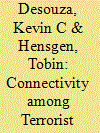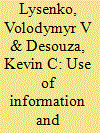|
|
|
Sort Order |
|
|
|
Items / Page
|
|
|
|
|
|
|
| Srl | Item |
| 1 |
ID:
077787


|
|
|
|
|
| Publication |
2007.
|
| Summary/Abstract |
The reality of terrorism has become ubiquitous. Terrorist groups continue to garner front-page exposure, which contributes to their agenda, while stories of hostage dilemmas, suicide bombings, assassinations, and a variety of nefarious criminal activities lead the unsuspecting to wonder, "What's next?" In order to begin to understand terrorism researchers should first understand how these terrorist groups operate and, far more importantly, what motivates others to co-operate with terrorists. No terrorist group operates in isolation. It is assured a priori that terrorist groups have to collaborate with other entities in order to further their agenda. In the conventional sense, terrorists have limited resources, limited capabilities, and limited reach. Without co-operation and support in support of criminal enterprises, they would function in isolation; their impact would be isolated. This article outlines two models that demonstrate how cooperation between terrorists and recognized, albeit criminal, institutions contribute to terrorist successes. The first, a resource model, outlines some of the resources that bind two or more terrorist groups. The second, an alliance model, layers different levels of collaborative engagements between terrorist groups and these institutions. Both models are descriptive in nature and contribute to an understanding of how terrorist groups must engage in the fundamentals of established economic practices in order to succeed.
|
|
|
|
|
|
|
|
|
|
|
|
|
|
|
|
| 2 |
ID:
131605


|
|
|
|
|
| Publication |
2014.
|
| Summary/Abstract |
Intelligence is a critical component for all counter-proliferation activities. It allows us to assess and determine what makes up the current threat environment in terms of the proliferation of nuclear weapons and technology. When informed with an accurate assessment of the situation, policy-makers are better suited to counter the proliferation threat. However, success and failure hinge upon how well information is managed during the intelligence process. The intelligence process as it relates to estimating nuclear capabilities or intentions is wrought with many challenges and complications. The denial and deception techniques employed by states running covert weapons programs and the dual-use nature of many weapons components create many difficulties for intelligence organizations. Additionally, illicit transnational networks obscure the situation further by serving as a source, for both nation states and non-state actors, for acquiring dual-use commodities and technologies. These challenges can lead to the miscalculation of a state's capabilities or intentions, as witnessed with the case of Iraq in 2003 when western intelligence services grossly overestimated the capabilities of Saddam's regime. This paper presents a comparative analysis of three cases of nuclear proliferation: India's 1998 nuclear tests, the exposure of the A. Q. Khan network and Iran's nuclear program. Drawing from the analysis, the authors examine the lessons learned and propose recommendations for future counter proliferation policy and strategy.
|
|
|
|
|
|
|
|
|
|
|
|
|
|
|
|
| 3 |
ID:
139272


|
|
|
|
|
| Summary/Abstract |
Information and communication technology have played an important role in the tactics of uprisings against non-democratic regimes worldwide. However, there has been little attention paid in studies so far of how authorities in those countries employ such information and communication technology. In this article we examine the evolution of such tactics as employed by one of the most ingrained authoritarian regimes—that of Belarus—during the decade 2001 to 2010. The political opposition's responses to the authorities' countermeasures are also investigated, followed by an analysis of the co-evolution of these opponents' tactics.
|
|
|
|
|
|
|
|
|
|
|
|
|
|
|
|
|
|
|
|
|